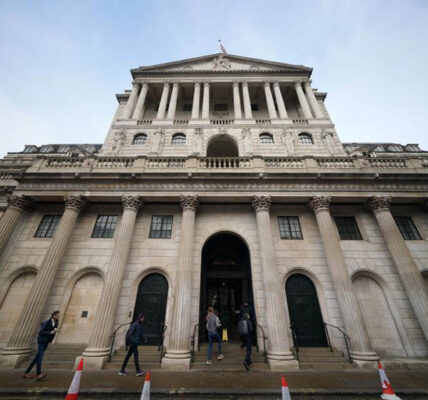UK Budget Impact on Bank of England Rate Cuts
This story explores the UK budget’s impact on Bank of England rate cuts, highlighting how recent fiscal policies affect inflation and monetary policy expectations.
The UK budget impact on Bank of England rate cuts is significant, especially after the announcement of the largest tax increases in thirty years by Finance Minister Rachel Reeves. Her budget aims to tackle the challenges facing the country’s public services, which she described as “broken.”

© Thomson Reuters
A Big Spending Budget
The UK government is facing pressing issues with its public services. To address these problems, Reeves has proposed a hefty spending plan. While this might help in the short term, it also raises concerns about rising inflation. The Office for Budget Responsibility (OBR), which provides essential forecasts for the government, anticipates that the budget will add half a percentage point to the consumer price growth rate next year.
Prior to this budget, Britain was already grappling with high inflation, driven largely by significant wage growth and strong price pressures from domestic services. These factors have set the UK apart as an inflation outlier compared to other nations.
Inflation Forecasts and Expectations
With the new budget measures in place, the OBR has revised its inflation forecast to an average of 2.6% for the next year, significantly up from the previous estimate of 1.5%. This adjustment has led investors to reassess their expectations for interest rate cuts by the Bank of England (BoE).
Before the budget announcement, there was a strong consensus among investors that the BoE would likely reduce interest rates rapidly over the coming year. However, the new budget has made it clear that the outlook for such cuts has shifted. As a result, investors are less optimistic about seeing quick rate cuts from the central bank.
Rate Cut Expectations Dwindle
Despite the changing landscape, investors still anticipate that the Bank of England will cut rates by a quarter of a percentage point on November 7. However, the likelihood of additional cuts in the following year has decreased significantly. Prior to the budget, the markets were pricing in nearly five cuts; now, they expect fewer than four.
The uncertainty surrounding the BoE’s rate-cutting path is further complicated by the budget’s impact on growth and inflation. As J.P. Morgan economist Allan Monks noted, the demand and inflation levels are likely to be higher than expected over the BoE’s two-year forecast horizon. This makes it increasingly challenging for the central bank to shift from its cautious approach to monetary policy.
The Bond Market Reaction
The immediate reaction in the bond market following the budget announcement was notable. Short-dated British government bonds experienced a selloff, with two-year gilt yields rising by 10 basis points to reach 4.42%. The yields on 10-year bonds touched their highest levels in nearly a year, reaching 4.44%, up 9 basis points.
Investors reacted to the budget’s implications for future interest rate cuts and the overall economic environment. The uncertainty surrounding the BoE’s decision-making process will likely continue to affect bond market performance in the near term.
The Bank of England’s Dilemma
With the November 7 rate decision approaching, the Bank of England faces a complex challenge. Typically, the BoE’s staff would have a draft of their quarterly economic forecast ready by now. However, the budget’s implications will require policymakers to reevaluate their forecasts as they prepare for discussions on interest rates.
Governor Andrew Bailey has previously stated that the BoE could adopt a more aggressive stance on rate cuts if inflation pressures ease. Yet, given the recent budgetary measures and the OBR’s assessment that GDP growth will be higher next year, it becomes more difficult for the BoE to justify a faster pace of rate cuts.
Fiscal Rules and Economic Outlook
The OBR has indicated that Reeves will only meet her new fiscal rules by a narrow margin. This means that while the budget aims to stimulate economic growth, it does so while increasing the risk of higher inflation. The OBR’s revised forecasts for inflation and growth, along with the outlook for the Bank Rate, reflect the complex dynamics at play in the UK economy.
As a result, markets have adjusted their expectations for the BoE’s actions. Investors are now pricing in a more cautious approach from the central bank in response to the new fiscal policies.
Long-Term Considerations
Despite the immediate negative reaction in the bond market, some investors remain optimistic about gilts (government bonds). PIMCO economist Peder Beck-Friis noted that they still favor gilts, believing that over time, the market will likely price in a lower terminal rate for the Bank of England’s cutting cycle.
James Smith, a developed markets economist at ING, echoed this sentiment, suggesting that gilt prices may have dropped too much. He pointed out that the BoE’s response to fiscal loosening earlier in the year was relatively muted, which might suggest it could pursue more aggressive rate cuts than the market currently expects.
Conclusion
The UK budget impact on Bank of England rate cuts presents a complex scenario for investors and policymakers alike. While the ambitious spending plans aim to address critical public service needs, they also raise concerns about inflation and interest rates. The updated inflation forecasts and shifting market expectations highlight the challenges the Bank of England faces in navigating this fiscal landscape.
As the November rate decision approaches, the BoE will need to carefully consider the implications of the new budget while balancing its commitment to controlling inflation and supporting economic growth. Only time will tell how these factors will unfold, but for now, the budget’s impact on interest rates remains a critical focus for the UK economy.
Related:
Bank of England Interest Rate Cut: A 100% Game-Changer for Homeowners?



